Vimy Memorial
Roll of Honour
A - D
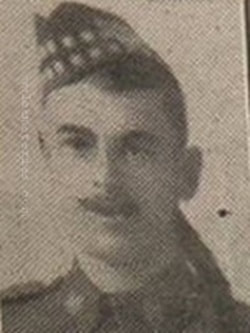
129662 Private
Arthur Edwin Baggs
72nd Bn. Canadian Infantry
1st March 1917, aged 28.
Son of Edwin and Louisa Mary Baggs, of 3605, Knight Rd., Vancouver, B.C.
Arthur Edwin Baggs
72nd Bn. Canadian Infantry
1st March 1917, aged 28.
Son of Edwin and Louisa Mary Baggs, of 3605, Knight Rd., Vancouver, B.C.
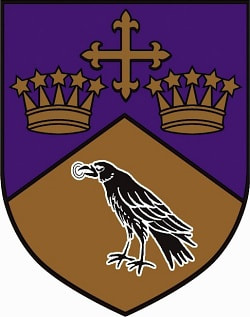
427830 Private
Stanley Edward Bailey
28th Bn. Canadian Infantry
26th September 1916.
The information below supplied by 'The Ellesmerian Club', the alumni organisation for Ellesmere College where Stanley was a pupil.
Stanley Edward Bailey
28th Bn. Canadian Infantry
26th September 1916.
The information below supplied by 'The Ellesmerian Club', the alumni organisation for Ellesmere College where Stanley was a pupil.
Stanley Edward Bailey was the youngest of four children of George & Mary Anne Bailey. He was born on 24th October 1881 in Tynemouth, Northumberland and had an elder brother, John George, and two elder sisters, Mary and Ellen. Sadly, misfortune struck the family as the 1891 Census shows that by then their mother had been widowed.
Stanley was not quite sixteen years old when he was admitted to Ellesmere College, north Shropshire. He was one of twenty-seven new boys that term and was allocated a bed in the ‘Edward’ dormitory and a desk in Form Lower II under the instruction of Mr. G. P. de Martin, himself an Old Ellesmerian. A fellow entrant to the ‘Edward’ dormitory was Warren Ash and, like Stanley, he emigrated to Canada and subsequently enlisted in the Canadian Expeditionary Force. He was to die in November 1914, just weeks after the outbreak of war. Another new boy that term that Stanley would have befriended was Frank Newenham Harvey, one of the five brothers who arrived at Ellesmere at the end of the 19th Century and “who were the most outstanding, and by far the ablest family group educated at this school”.
Despite boarding at the college for two years, there is no mention of Stanley in The Ellesmerian with regards to his being in any school or dormitory sports team or participating in any extra-curricular activities. He left Ellesmere at the end of December 1899 and never kept in contact with the college or the Old Ellesmerian Club.
The 1901 Census records that Stanley was employed as a clerk in a glass warehouse in Worcester. He was single and lived with his mother.
On 30th August 1903 Stanley decided to enrol in the British Army and signed the necessary Attestation Papers in Bury to become Private Bailey, Service No. 9746 in the Lancashire Fusiliers. However, his military career was cut short after three months when he was formally discharged on 30th November as the military authorities decided he was “not likely to become an efficient soldier”.
Exactly when Stanley decided to set sail for a new life in Canada has not been discovered but no trace of him being in England can be found in the 1911 Census.
Stanley signed a second set of Attestation Papers on 6th August 1915 in Regina, Sasketchewan when he enlisted as Private Stanley, Service No: 427830 in the 68th Battalion, the Canadian Expeditionary Force. He was three months short of his 34th birthday and was employed as a labourer.
He commenced his basic training and on 12th October he was transferred to the 46th Battalion. Just nine days later, at Halifax, he embarked for the sea voyage to England. Further training followed but in January he found himself in hospital at Folkestone where the medics were concerned about his vision. However, this did not prevent him from continuing with his training and on 8th June that year he embarked for active service in France. He marched into the Canadian base depot at Le Havre on 9th June and was taken on strength by the 28th Battalion.
Nothing is known as regards his movements or where he saw action other than that he was admitted to the No. 6 Canadian Field Ambulance with a sprained ankle towards the end of August. He would, almost certainly, have been put on light duties for a while but he was soon back in action as he was killed on 26th September. Another Ellesmerian, George Gilbert Tudor Jones, who also served with the Canadian Expeditionary Force, died that day too. They were not contemporaries whilst at the college.
For his military service Stanley was awarded the Victory Medal and the British War Medal. His medals and Memorial Plaque were sent to his mother who still lived in Worcester. The sacrifice of Stanley is commemorated on the Vimy Memorial where his name is listed alongside 11,241 other men who have no known grave. In October 2017, his name was also added to the War Memorial at Ellesmere College.
Stanley was not quite sixteen years old when he was admitted to Ellesmere College, north Shropshire. He was one of twenty-seven new boys that term and was allocated a bed in the ‘Edward’ dormitory and a desk in Form Lower II under the instruction of Mr. G. P. de Martin, himself an Old Ellesmerian. A fellow entrant to the ‘Edward’ dormitory was Warren Ash and, like Stanley, he emigrated to Canada and subsequently enlisted in the Canadian Expeditionary Force. He was to die in November 1914, just weeks after the outbreak of war. Another new boy that term that Stanley would have befriended was Frank Newenham Harvey, one of the five brothers who arrived at Ellesmere at the end of the 19th Century and “who were the most outstanding, and by far the ablest family group educated at this school”.
Despite boarding at the college for two years, there is no mention of Stanley in The Ellesmerian with regards to his being in any school or dormitory sports team or participating in any extra-curricular activities. He left Ellesmere at the end of December 1899 and never kept in contact with the college or the Old Ellesmerian Club.
The 1901 Census records that Stanley was employed as a clerk in a glass warehouse in Worcester. He was single and lived with his mother.
On 30th August 1903 Stanley decided to enrol in the British Army and signed the necessary Attestation Papers in Bury to become Private Bailey, Service No. 9746 in the Lancashire Fusiliers. However, his military career was cut short after three months when he was formally discharged on 30th November as the military authorities decided he was “not likely to become an efficient soldier”.
Exactly when Stanley decided to set sail for a new life in Canada has not been discovered but no trace of him being in England can be found in the 1911 Census.
Stanley signed a second set of Attestation Papers on 6th August 1915 in Regina, Sasketchewan when he enlisted as Private Stanley, Service No: 427830 in the 68th Battalion, the Canadian Expeditionary Force. He was three months short of his 34th birthday and was employed as a labourer.
He commenced his basic training and on 12th October he was transferred to the 46th Battalion. Just nine days later, at Halifax, he embarked for the sea voyage to England. Further training followed but in January he found himself in hospital at Folkestone where the medics were concerned about his vision. However, this did not prevent him from continuing with his training and on 8th June that year he embarked for active service in France. He marched into the Canadian base depot at Le Havre on 9th June and was taken on strength by the 28th Battalion.
Nothing is known as regards his movements or where he saw action other than that he was admitted to the No. 6 Canadian Field Ambulance with a sprained ankle towards the end of August. He would, almost certainly, have been put on light duties for a while but he was soon back in action as he was killed on 26th September. Another Ellesmerian, George Gilbert Tudor Jones, who also served with the Canadian Expeditionary Force, died that day too. They were not contemporaries whilst at the college.
For his military service Stanley was awarded the Victory Medal and the British War Medal. His medals and Memorial Plaque were sent to his mother who still lived in Worcester. The sacrifice of Stanley is commemorated on the Vimy Memorial where his name is listed alongside 11,241 other men who have no known grave. In October 2017, his name was also added to the War Memorial at Ellesmere College.

551107 Trooper
Thomas George Bavin
Lord Strathcona's Horse (Royal Canadians)
1st December 1917, aged 25.
Son of Mrs. T. Bavin, of Bucklands, Crown Hill, South Devon, England.
The information below supplied by 'The Ellesmerian Club', the alumni organisation for Ellesmere College where Thomas was a pupil.
Thomas George Bavin
Lord Strathcona's Horse (Royal Canadians)
1st December 1917, aged 25.
Son of Mrs. T. Bavin, of Bucklands, Crown Hill, South Devon, England.
The information below supplied by 'The Ellesmerian Club', the alumni organisation for Ellesmere College where Thomas was a pupil.
Thomas George Bavin fought in the same regiment, Lord Strathcona’s Horse, as another Ellesmerian, Frederick M. W. Harvey, V.C. Their time at Ellesmere College overlapped by a year with Thomas arriving in May 1901 and Frederick leaving at Easter 1902. We will never know if they met, but it is interesting to think that they recognised one another and reminisced about their days at Ellesmere. Was Thomas involved in the attack of March 1917 when Harvey won his Victoria Cross? Again, a thought which must remain just that.
Thomas followed his elder brother, Ernest William, to Ellesmere at Easter, 1901. Ernest had arrived in January of that year. Thomas came from the Douglas School, Cheltenham where he had been for three years. He was not quite ten years old when he went into Form Lower I under the tutelage of Mr. Evans. Being so young he obviously did not immediately represent his dormitory, the ‘Harold’, on the sports field. He did, however, join the choir as a treble.
The first mention in The Ellesmerian of Thomas being involved in sport is when he won the Under 12 plunge and one length race. He also did his five lengths in cricket flannels in the summer of 1904 to pass his swimming test. By 1905 he was representing the ‘Harold’ at cricket, although without any startling success. He was a member of the Officer Training Corps, taking part in the class firing where he was classed as “very good”.
When he left Ellesmere at the end of the autumn term 1906, he went to live with his mother and sister in Acton Green, London and became a “Bank Student”. The records suggest that in August 1912 Thomas, together with his mother and sister sailed for Canada on the ss Corinthian to be with Ernest who had been there since 1908. Eventually, his mother and sister returned to England whilst Thomas remained with his intended calling given as “farmer”.
This would not appear to have been what happened for his Attestation Papers give his occupations as commercial traveller and then policeman - like his brother he had joined the Royal Northwest Mounted Police. Thomas signed these papers on 7th January 1916 in Winnipeg, Manitoba, but as he had enlisted in September 1915, he was soon on his way to England where he landed on 31st January 1916. In May of that year he was taken on the strength of Lord Strathcona’s Horse (Royal Canadians).
This was a cavalry regiment which had given up its mounts to satisfy the demand for infantry. As Thomas arrived in England so the regiment was reconstituted as a mounted force. The Lord Strathcona’s were sent to the Somme in June 1916, but the nature of the warfare afforded few opportunities for cavalry operations. In late November 1917, the regiment took part in the battle of Cambrai. The mass use of tanks brought some success to the Allies. The strong German counterattack, however, caused the Lord Strathcona’s to be put into the line as infantry.
Fourteen of the regiment were killed on 1st December 1917; among them was Private Bavin, Service No: 551107. The Circumstances of Casualty Report reads: “This soldier was killed by an enemy bullet while taking part with his Regiment in an attack”. The location of his unit at the time of his death was Gauche Wood. A report says that he was buried where he fell but his body could not be found at a later exhumation. He is remembered on the Vimy Memorial.
Thomas followed his elder brother, Ernest William, to Ellesmere at Easter, 1901. Ernest had arrived in January of that year. Thomas came from the Douglas School, Cheltenham where he had been for three years. He was not quite ten years old when he went into Form Lower I under the tutelage of Mr. Evans. Being so young he obviously did not immediately represent his dormitory, the ‘Harold’, on the sports field. He did, however, join the choir as a treble.
The first mention in The Ellesmerian of Thomas being involved in sport is when he won the Under 12 plunge and one length race. He also did his five lengths in cricket flannels in the summer of 1904 to pass his swimming test. By 1905 he was representing the ‘Harold’ at cricket, although without any startling success. He was a member of the Officer Training Corps, taking part in the class firing where he was classed as “very good”.
When he left Ellesmere at the end of the autumn term 1906, he went to live with his mother and sister in Acton Green, London and became a “Bank Student”. The records suggest that in August 1912 Thomas, together with his mother and sister sailed for Canada on the ss Corinthian to be with Ernest who had been there since 1908. Eventually, his mother and sister returned to England whilst Thomas remained with his intended calling given as “farmer”.
This would not appear to have been what happened for his Attestation Papers give his occupations as commercial traveller and then policeman - like his brother he had joined the Royal Northwest Mounted Police. Thomas signed these papers on 7th January 1916 in Winnipeg, Manitoba, but as he had enlisted in September 1915, he was soon on his way to England where he landed on 31st January 1916. In May of that year he was taken on the strength of Lord Strathcona’s Horse (Royal Canadians).
This was a cavalry regiment which had given up its mounts to satisfy the demand for infantry. As Thomas arrived in England so the regiment was reconstituted as a mounted force. The Lord Strathcona’s were sent to the Somme in June 1916, but the nature of the warfare afforded few opportunities for cavalry operations. In late November 1917, the regiment took part in the battle of Cambrai. The mass use of tanks brought some success to the Allies. The strong German counterattack, however, caused the Lord Strathcona’s to be put into the line as infantry.
Fourteen of the regiment were killed on 1st December 1917; among them was Private Bavin, Service No: 551107. The Circumstances of Casualty Report reads: “This soldier was killed by an enemy bullet while taking part with his Regiment in an attack”. The location of his unit at the time of his death was Gauche Wood. A report says that he was buried where he fell but his body could not be found at a later exhumation. He is remembered on the Vimy Memorial.
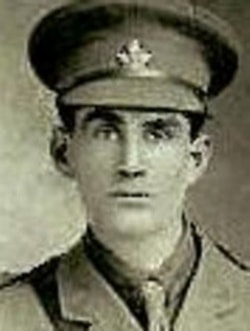
Captain
Robert Fleming Bell
25th Bn. Canadian Infantry, (Nova Scotia Regiment)
28th April 1917, aged 31.
Son of George Walter and Emily Bell, of Meadow Creek, Alberta.
O. C. 2nd Troop B, 13th Sqn. 25th Battalion, Canadian Infantry, (Nova Scotia Regiment)
Picture courtesy of great nephew, Captain Kevin Daggitt, CIC (Air) Canadian forces)
Robert Fleming Bell
25th Bn. Canadian Infantry, (Nova Scotia Regiment)
28th April 1917, aged 31.
Son of George Walter and Emily Bell, of Meadow Creek, Alberta.
O. C. 2nd Troop B, 13th Sqn. 25th Battalion, Canadian Infantry, (Nova Scotia Regiment)
Picture courtesy of great nephew, Captain Kevin Daggitt, CIC (Air) Canadian forces)
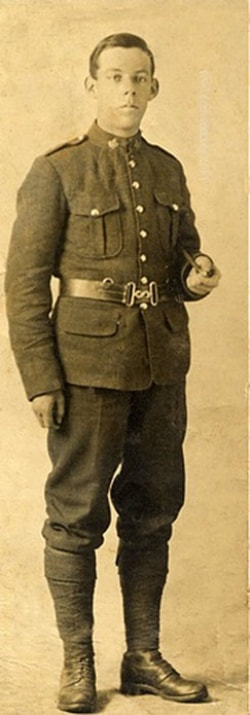
441163 Private
Ronald Bellew
14th Bn. Canadian Infantry
26th September 1916, aged 22.
Born 30th April 1894, Bishops Nympton, Devonshire - Son of Charles and Rebecca (Annie) Bellew, of Folly Cottage, South Molton, Devon, England.
Killed in action 26th September 1916, battle of Thiepval Ridge.
Picture courtesy of niece, Angela Bavidge
Ronald Bellew
14th Bn. Canadian Infantry
26th September 1916, aged 22.
Born 30th April 1894, Bishops Nympton, Devonshire - Son of Charles and Rebecca (Annie) Bellew, of Folly Cottage, South Molton, Devon, England.
Killed in action 26th September 1916, battle of Thiepval Ridge.
Picture courtesy of niece, Angela Bavidge
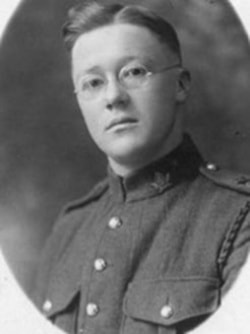
715094 Private
Lyle Whidden Bryson
25th Bn. Canadian Infantry
9th April 1917, aged 19.
Son of McCully and Lilly Bryson, of Hilden, Colchester Co., Nova Scotia.
His brother Lieutenant Elmer Bryson was also killed and is buried at Adanac Military Cemetery, Miraumont
Picture courtesy of his nephew, Lyle L. Bryson
Lyle Whidden Bryson
25th Bn. Canadian Infantry
9th April 1917, aged 19.
Son of McCully and Lilly Bryson, of Hilden, Colchester Co., Nova Scotia.
His brother Lieutenant Elmer Bryson was also killed and is buried at Adanac Military Cemetery, Miraumont
Picture courtesy of his nephew, Lyle L. Bryson

228335 Private
William Stanley Burton
Royal Canadian Regiment
23rd August 1917, aged 30.
Son of Kate Annie Burton, of Talbot Hotel, Leominster, Herefordshire, England, and the late William Alfred Burton.
The information below supplied by 'The Ellesmerian Club', the alumni organisation for Ellesmere College where William was a pupil.
William Stanley Burton
Royal Canadian Regiment
23rd August 1917, aged 30.
Son of Kate Annie Burton, of Talbot Hotel, Leominster, Herefordshire, England, and the late William Alfred Burton.
The information below supplied by 'The Ellesmerian Club', the alumni organisation for Ellesmere College where William was a pupil.
William Stanley Burton was born in Frome, Somerset on 18th May 1887. He was the elder son of William and Katie Burton and, following their separation, his mother moved to Leominster, Herefordshire where she became the proprietor of The Talbot Hotel. It was from here that William joined Ellesmere College in January 1901, being allocated to the ‘Edward’ dormitory. When he arrived at Ellesmere, there were one hundred and ninety one pupils on the nominal roll and he was placed in Form Upper IV, under the guidance of Mr. Rodgers.
William stayed at Ellesmere for three years, leaving in December 1903; he took a full and active part in college life during that time. He played cricket and rugby for both the college and his dormitory teams, being awarded his full Colours in both sports, and he further demonstrated his skill in the swimming pool in the 1902 Sports. He was elected a member of the Games Committee but still found time to enjoy a role in the 1903 Shakespearian production of “The Merchant of Venice”. In the classroom, he passed his Senior Oxford Local Examinations.
In his last year, he was appointed Prefect and, like almost all members of college, he was a member of the Officer Training Corps, being promoted Sergeant in his pen-ultimate term. He was awarded his shooting proficiency certificate in 1902 – he was rated ‘very good’.
On leaving Ellesmere in December 1903, he returned to Leominster and joined a firm of auctioneers and he saw service during this time with the 2nd Battalion (Territorial Force), the King’s Shropshire Light Infantry.
Emigration records of the time show that William embarked on the ss Tunisian in August 1913, bound for a new life in Canada. On his Attestation Papers, he indicated that he was still single and farmed at Lake McGregor, Alberta.
On May 8th1916, William enlisted as Private Burton, Service No. 228335 in the 13th Regiment, the Canadian Mounted Rifles at Medicine Hat, Alberta, Canada and by July of that year he had arrived at the Canadian Base Depot at Shorncliffe, England. Some six weeks later he was posted ‘overseas’.
His service records reveal that he suffered vision problems, necessitating his admission to the No. 9 Canadian Field Ambulance for some hospital treatment in the spring of 1917 for a few days. However, a month later he was admitted to the No. 1 Canadian General Hospital at Etaples suffering problems with his right shoulder – this necessitated a further week long stay in hospital.
During the conflict some 617,000 Canadians joined the Canadian Expeditionary Force and William was one of the 59,000 who did not return home.
He was wounded at Vimy Ridge, near Lens, and died on 23rd August 1917.
In a letter to his mother, Captain McCallum said:
“I am sure it will be a comfort to know that we all held your son in high regard and esteem. He was one of the very best men in the company and his conduct was always an example to all ranks. We knew his worth, and the memory of his work will help us to ‘carry on’ in his footsteps”.
William is commemorated on the Vimy Memorial and in the Canadian First World War Book of Remembrance.
William stayed at Ellesmere for three years, leaving in December 1903; he took a full and active part in college life during that time. He played cricket and rugby for both the college and his dormitory teams, being awarded his full Colours in both sports, and he further demonstrated his skill in the swimming pool in the 1902 Sports. He was elected a member of the Games Committee but still found time to enjoy a role in the 1903 Shakespearian production of “The Merchant of Venice”. In the classroom, he passed his Senior Oxford Local Examinations.
In his last year, he was appointed Prefect and, like almost all members of college, he was a member of the Officer Training Corps, being promoted Sergeant in his pen-ultimate term. He was awarded his shooting proficiency certificate in 1902 – he was rated ‘very good’.
On leaving Ellesmere in December 1903, he returned to Leominster and joined a firm of auctioneers and he saw service during this time with the 2nd Battalion (Territorial Force), the King’s Shropshire Light Infantry.
Emigration records of the time show that William embarked on the ss Tunisian in August 1913, bound for a new life in Canada. On his Attestation Papers, he indicated that he was still single and farmed at Lake McGregor, Alberta.
On May 8th1916, William enlisted as Private Burton, Service No. 228335 in the 13th Regiment, the Canadian Mounted Rifles at Medicine Hat, Alberta, Canada and by July of that year he had arrived at the Canadian Base Depot at Shorncliffe, England. Some six weeks later he was posted ‘overseas’.
His service records reveal that he suffered vision problems, necessitating his admission to the No. 9 Canadian Field Ambulance for some hospital treatment in the spring of 1917 for a few days. However, a month later he was admitted to the No. 1 Canadian General Hospital at Etaples suffering problems with his right shoulder – this necessitated a further week long stay in hospital.
During the conflict some 617,000 Canadians joined the Canadian Expeditionary Force and William was one of the 59,000 who did not return home.
He was wounded at Vimy Ridge, near Lens, and died on 23rd August 1917.
In a letter to his mother, Captain McCallum said:
“I am sure it will be a comfort to know that we all held your son in high regard and esteem. He was one of the very best men in the company and his conduct was always an example to all ranks. We knew his worth, and the memory of his work will help us to ‘carry on’ in his footsteps”.
William is commemorated on the Vimy Memorial and in the Canadian First World War Book of Remembrance.
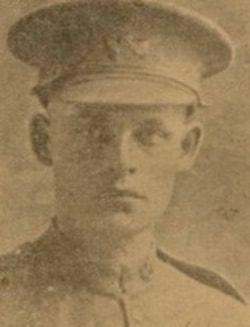
838492 Private
Campbell Clark
4th Canadian Mounted Rifles, (Central Ontario Regiment)
23rd April 1917, aged 22.
Son of Duncan and Maria Clark, of 615, 8th Street East, Owen Sound, Ontario. Enlisted in 147th Grey Bn. Nov., 1915.
Campbell Clark
4th Canadian Mounted Rifles, (Central Ontario Regiment)
23rd April 1917, aged 22.
Son of Duncan and Maria Clark, of 615, 8th Street East, Owen Sound, Ontario. Enlisted in 147th Grey Bn. Nov., 1915.
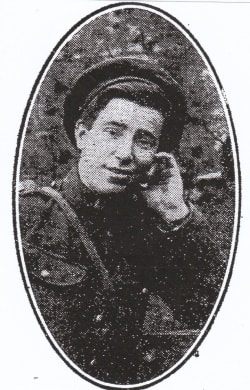
451203 Private
Thomas Coombe
58th Bn. Canadian Infantry
22nd January 1917, aged 25.
(Commonwealth War Graves Commission have incorrect spelling of surname)
Camelford Roll of Honour
Extract taken from the Cornish & Devon Post on the 24th February 1917.
Further particulars are to hand regarding the death of Pte. T. Coombe of Camelford, killed in action on Jan 22nd, whose portrait we reproduce. This young man was 25 years of age in May last. After being employed by Mr. W. S. Ward of Greylake Camelford as an agricultural workman he emigrated to Canada in April 1912 and enlisted in the Canadian Army on May 17th 1915. The chaplain in his letter to the relatives at Camelford states that he met his death instantaneously owing to the explosion of a shell and while at the post of duty. Two officers attended his burial service on January 24th. The popularity which Pte. T. Coombe enjoyed among his comrades in the army was only equaled by that he merited and received among his associates in his native district. He was an industrious youth of good principles and much regret has been expressed at his death. His only two brothers are serving, one in the Army and one in the Navy.
Thomas Coombe
58th Bn. Canadian Infantry
22nd January 1917, aged 25.
(Commonwealth War Graves Commission have incorrect spelling of surname)
Camelford Roll of Honour
Extract taken from the Cornish & Devon Post on the 24th February 1917.
Further particulars are to hand regarding the death of Pte. T. Coombe of Camelford, killed in action on Jan 22nd, whose portrait we reproduce. This young man was 25 years of age in May last. After being employed by Mr. W. S. Ward of Greylake Camelford as an agricultural workman he emigrated to Canada in April 1912 and enlisted in the Canadian Army on May 17th 1915. The chaplain in his letter to the relatives at Camelford states that he met his death instantaneously owing to the explosion of a shell and while at the post of duty. Two officers attended his burial service on January 24th. The popularity which Pte. T. Coombe enjoyed among his comrades in the army was only equaled by that he merited and received among his associates in his native district. He was an industrious youth of good principles and much regret has been expressed at his death. His only two brothers are serving, one in the Army and one in the Navy.
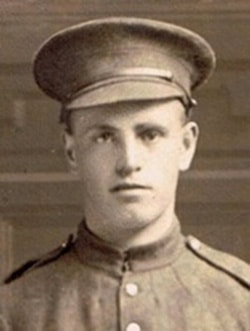
784602 Private
Stephen Duckhouse
87th Bn. Canadian Infantry, (Quebec Regiment)
14th August 1917, aged 20.
Son of Mrs. E. Baggott (formerly Duckhouse), of 47, Little Green Lane, Small Heath, Birmingham, England.
Private Stephen Duckhouse was born in 1897 in Birmingham, England and in 1910 was sent out to Canada as a Home Child. There he resided with Edgar McPhail, Ada Alde McPhail and John A. McPhail until 1916, when he joined the C.E.F. 129th Wentworth Battalion Regiment in Dundas, Wentworth Country Ontario. Although under age, he said that he wanted to do his duty. Later in Europe, he became part of the 87th Battalion and took part in the the Hill 70 initiative during which he along with 9 other men were found dead in the Loos sector on August 14th, 1917 behind enemy lines. This event was later recounted in the Toronto Star.
Fondly remembered by the family of Edgar McPhail, Ada Alde McPhail and John A McPhail. (Canadian Home Family)
Picture courtesy of Margaret Bonham McPhail from the collection of Edgar and Ada Alde McPhail
Stephen Duckhouse
87th Bn. Canadian Infantry, (Quebec Regiment)
14th August 1917, aged 20.
Son of Mrs. E. Baggott (formerly Duckhouse), of 47, Little Green Lane, Small Heath, Birmingham, England.
Private Stephen Duckhouse was born in 1897 in Birmingham, England and in 1910 was sent out to Canada as a Home Child. There he resided with Edgar McPhail, Ada Alde McPhail and John A. McPhail until 1916, when he joined the C.E.F. 129th Wentworth Battalion Regiment in Dundas, Wentworth Country Ontario. Although under age, he said that he wanted to do his duty. Later in Europe, he became part of the 87th Battalion and took part in the the Hill 70 initiative during which he along with 9 other men were found dead in the Loos sector on August 14th, 1917 behind enemy lines. This event was later recounted in the Toronto Star.
Fondly remembered by the family of Edgar McPhail, Ada Alde McPhail and John A McPhail. (Canadian Home Family)
Picture courtesy of Margaret Bonham McPhail from the collection of Edgar and Ada Alde McPhail




